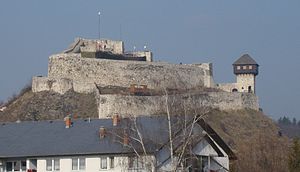- Fortress of Doboj
-
Doboj Fortress Doboj, Bosnia and Herzegovina
Doboj FortressCoordinates 44°44′13″N 18°05′17″E / 44.737°N 18.088°ECoordinates: 44°44′13″N 18°05′17″E / 44.737°N 18.088°E Doboj Fortress or "Gradina" is located in the city of Doboj in northern Bosnia and Herzegovina.[1]
Contents
History
One of the most important defenses in the medieval bannate/duchy of Usora, this large stone structure has been built in the early 13th century on the site of earlier, clay and wood-based structure from 10th/11th century. In the first period of its existence, (early 13th century) until the end of 14th/beginning of 15th century (1415), the fortress has been built in the Romanesque architecture style. This magnificent object has been burned and ransacked at least 18 times (per official/written record) in its history.
After the reconstruction of 1415 the Doboj fortress becomes more of a Gothic structure and has its donjon reinforced with thick walls (up to 3 feet or 1 meter thick at the Eastern wall) as well as addition of a bastion/plateau with six cannon on top of it. The captain's tower was the dominating feature with a very tall and square donjon (eng: dungeon) dominating the fortress. Three big towers (North-West, Eastern, and Southern Gate) strategically protected the flanks of the fortress, hence rendering any idea of an attack a suicidal attempt. The Southern tower's walls became round in order to deflect cannonballs (circa 1370-1380s) and local captains at the time used Dubrovnik-made cannons, bombards, and balistas as fortress' main defense weaponry (Dubrovnik was known as Republic of Ragusa at the time).
Role in Battle of Doboj
In the early August of the same year, Bosnian nobility with its armies (under command of The Great Bosnian Duke Hrvoje Vukcic-Hrvatinic) in the coalition with Ottoman Turks (under Isa-Beg) fought the Hungarians in the Battle of Doboj (1415). During this campaign the Hungarians (under Johannes de Gara and Johannes de Maroth) had had their main camp right under the fortress of Doboj and the main battle took place in the area of Makljenovac, 2 kilometers away from the fortress itself. Some 15,000 Hungarians faced the united Bosnian nobility (10,000 warriors strong, including most important Bosnian overlords - Hrvoje Vukcic, Sandalj Hranic, Pavao Radenovic, and Vuk Zlatonosovic from Usora Bannate) and their Ottoman allies (sources claim up to 15,000 + Ottoman Turks under Isa-Bey). The Hungarians were heavily defeated in this battle (most of the nobility was captured and ransomed later on) and were not to undertake any major offensive against the Turks or Bosnian kingdom until the Second Battle of Kosovo in 1448.
More history
Turks had conquered the city of Doboj and its fortress in 1476 and had the fortress completely reconstructed and gave it new shape by adding the outer wall and additional structures. In the Austrian/Turkish war (1697) Doboj fortress had been sacked and burnt by Prince Eugene of Savoy and his Austrian armies on the march to Sarajevo. The fortress had been conquered and burnt by Austrians again in the summer of 1717. In 1740, Turks have added a torture chamber to the fortress's interior but its garrison at the time consists of only 40+ standing soldiers. Doboj fortress loses its military significance in the late 18/early 19th century as the Turkish borders shift dramatically in the Austrian/Turkish Wars, and later Napoleonic wars on Balkans and elsewhere.
Capture by Austro-Hungarians
In 1878, Austro-Hungarian armies captured the fortress after the battle with a local population. At the beginning of 20th century, Doboj fortress had lost its military importance, but remains one of the most important medieval structures in Bosnia and Herzegovina and the best known symbol of modern city of Doboj.
References
External links
- Official web site of Doboj Fortress
- First photo gallery of Doboj Fortress at DobojLive.com
- Second photo gallery of Doboj Fortress at DobojLive.com
- Picture gallery
 Bijela Tabija · Blagaj · Bobovac · Bočac Fortress · Bosanska Krupa Fortress · Bužim Castle · Captain's Citadel · Citadel Počitelj · Fazlagić Tower · Fortress of Doboj · Gradačac Castle · Greben Fort · Hodidjed · Hutovo Fort · Jajce Fortress · Kamengrad Fort · Kastel Fortress · Ključ Castle · Komotin Castle · Kotor Hrvoje's Fort · Ljubuški Herceg Stjepan's Fort · Maglaj Fortress · Momčilo's Citadel · Old town of Visoki · Orašac Fort · Ostrožac Castle · Oštrovica Castle · Prusac Fortress · Smajilagić's Citadel, Upper Town · Srebrenik Fortress · Tešanj Castle · Travnik Castle · Velika Kladuša Castle · Visuć Citadel (Black Queen's Citadel) · Vranduk Fortress · Vrnograč Castle · Vujadin's Citadel · Zvečaj Fort
Bijela Tabija · Blagaj · Bobovac · Bočac Fortress · Bosanska Krupa Fortress · Bužim Castle · Captain's Citadel · Citadel Počitelj · Fazlagić Tower · Fortress of Doboj · Gradačac Castle · Greben Fort · Hodidjed · Hutovo Fort · Jajce Fortress · Kamengrad Fort · Kastel Fortress · Ključ Castle · Komotin Castle · Kotor Hrvoje's Fort · Ljubuški Herceg Stjepan's Fort · Maglaj Fortress · Momčilo's Citadel · Old town of Visoki · Orašac Fort · Ostrožac Castle · Oštrovica Castle · Prusac Fortress · Smajilagić's Citadel, Upper Town · Srebrenik Fortress · Tešanj Castle · Travnik Castle · Velika Kladuša Castle · Visuć Citadel (Black Queen's Citadel) · Vranduk Fortress · Vrnograč Castle · Vujadin's Citadel · Zvečaj Fort Categories:
Categories:- Castles in Bosnia and Herzegovina
- Doboj
Wikimedia Foundation. 2010.


